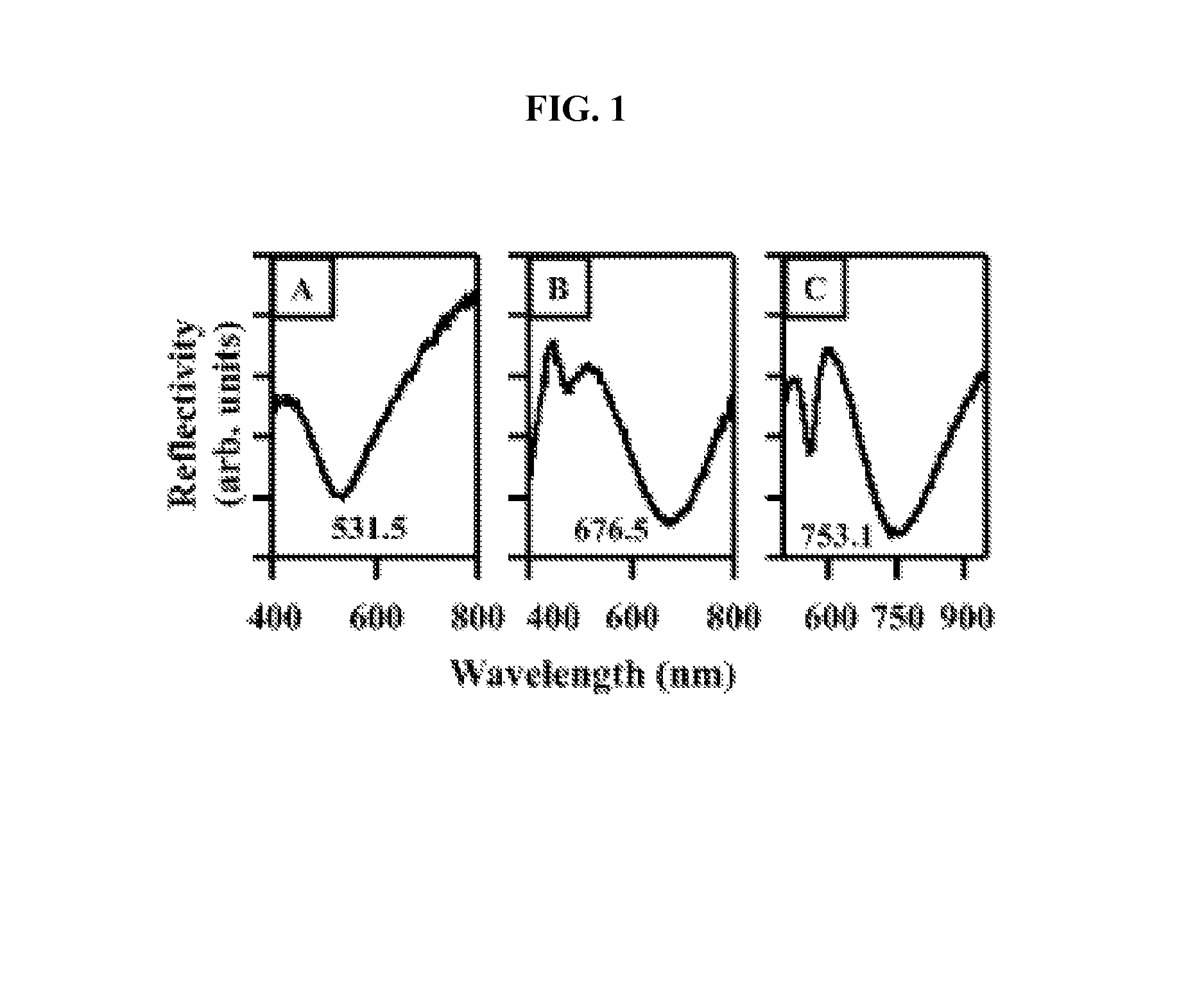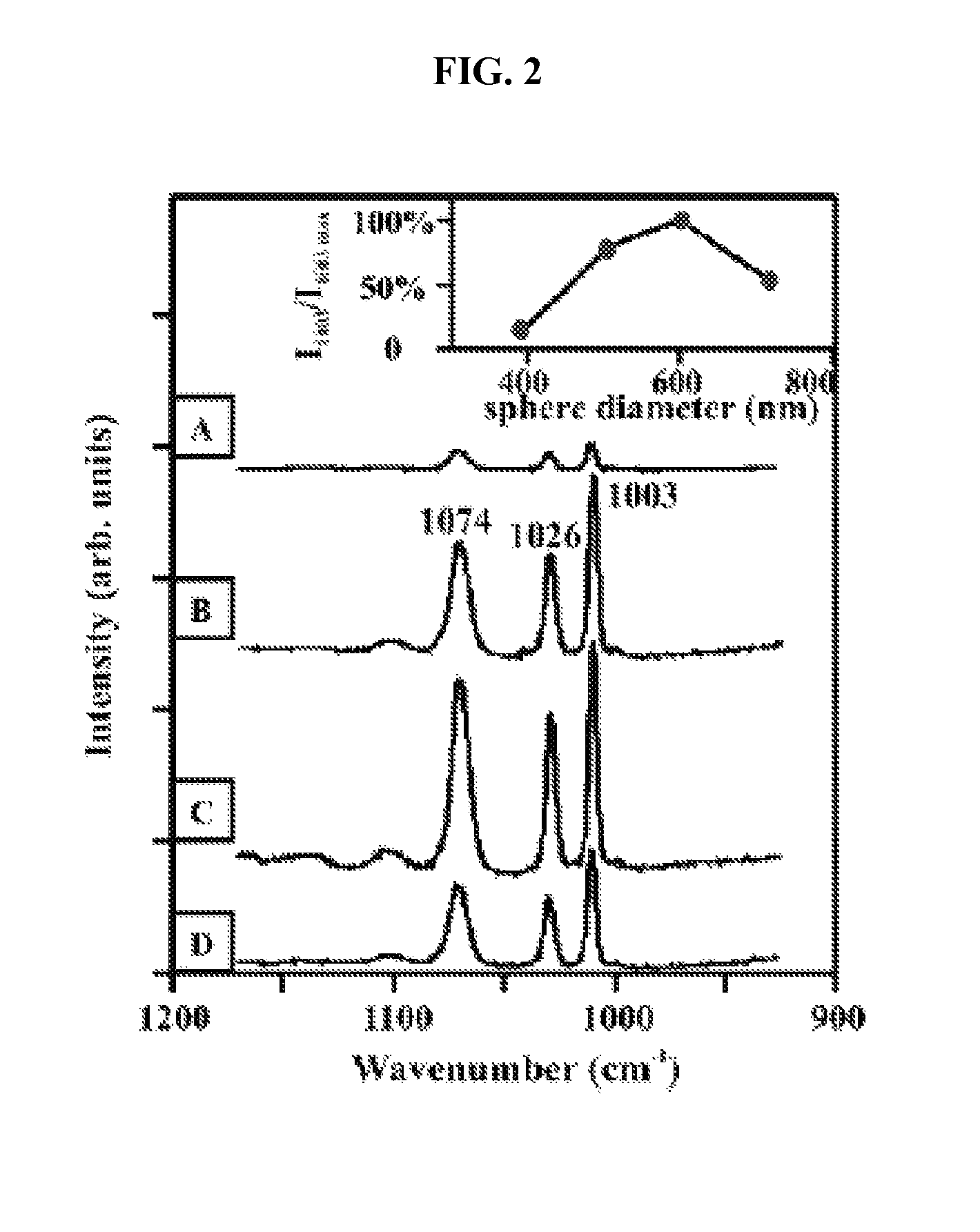Compositions, devices and methods for SERS and LSPR
a technology applied in the field of sers and lspr, can solve the problem of not immediately diagnosing anthrax, and achieve the effects of large sers enhancement factors, efficient extraction, and stable sers signal
- Summary
- Abstract
- Description
- Claims
- Application Information
AI Technical Summary
Benefits of technology
Problems solved by technology
Method used
Image
Examples
example 1
Microbial Culture
[0091]B. subtilis was purchased from the American Type Culture Collection (Manassas, Va.). Spore cultures were cultivated by spreading the vegetative cells on sterile nutrient agar plates (Fisher Scientific), followed by incubating at 30° C. for 6 days. The cultures were washed from the plates using sterile water and centrifuged at 12 000 g for 10 min. The centrifuging procedure was repeated five times. The lyophilized spores were kept at 2-4° C. prior to use. Approximately 1 g of sample was determined to contain 5.6×1010 spores by optical microscopic measurements (data not shown). The spore suspension was made by dissolving spores in 0.02 M HNO3 solution and by sonicating for 10 min.
example 2
Extraction of CaDPA from Spores
[0092]CaDPA was extracted from spores by sonicating in 0.02 M HNO3 solution for 10 min. This concentration of the HNO3 solution was selected because of its capability of extraction and its benign effect on the AgFON SERS activity. To test the efficiency of this extraction method, a 3.1×10−13 M spore suspension (3.7×104 spores in 0.2 μL, 0.02 M HNO3) was deposited onto an AgFON substrate (D=600 nm, dm=200 nm). The sample was allowed to evaporate for less than 1 min. A high signal to-noise ratio (S / N) SERS spectrum was obtained in 1 min (FIG. 3A). For comparison, a parallel SERS experiment was conducted using 5.0×10−4 M CaDPA (FIG. 3B). The SERS spectrum of B. subtilis spores is dominated by bands associated with CaDPA, in agreement with the previous Raman studies on bacillus spores. The SERS spectra in FIG. 3, however, display noticeable differences at 1595 cm-1, which are from the acid form of dipicolinate (Carmona, 1980, Spectrochim. Acta, Part A 36A:...
example 3
AgFON Substrate Fabrication
[0094]Glass substrates were pretreated in two steps; 1) Piranha etch, 3:1 H2SO4 / 30% H2O2 at 80° C. for 1 h, was used to clean the substrate, and 2) base treatment, of 5:1:1 H2O / NH4OH / 30% H2O2 with sonication for 1 h was used to render the surface hydrophilic. Approximately 2 μL of the nanosphere suspension (4% solids) was drop coated onto each substrate and allowed to dry in ambient conditions. The metal films were deposited in a modified Consolidated Vacuum Corporation vapor deposition system with a base pressure of 10−6 Torr (Hulteen and Van Duyne, 1995, J. Vac. Sci. Technol. A 13:1553-1558). The deposition rates for each film (10 Å / s) were measured using a Leybold Inficon XTM / 2 quartz crystal microbalance (QCM) (East Syracuse, N.Y.). AgFON substrates were stored in the dark at room temperature prior to use.
[0095]Alternatively, 2D self-assembled monolayer masks of nanospheres were fabricated by drop-coating approximately 2.54, of undiluted nanosphere sol...
PUM
| Property | Measurement | Unit |
|---|---|---|
| diameter | aaaaa | aaaaa |
| diameter | aaaaa | aaaaa |
| thickness | aaaaa | aaaaa |
Abstract
Description
Claims
Application Information
 Login to View More
Login to View More - R&D
- Intellectual Property
- Life Sciences
- Materials
- Tech Scout
- Unparalleled Data Quality
- Higher Quality Content
- 60% Fewer Hallucinations
Browse by: Latest US Patents, China's latest patents, Technical Efficacy Thesaurus, Application Domain, Technology Topic, Popular Technical Reports.
© 2025 PatSnap. All rights reserved.Legal|Privacy policy|Modern Slavery Act Transparency Statement|Sitemap|About US| Contact US: help@patsnap.com



